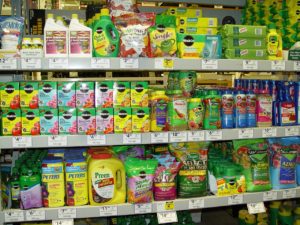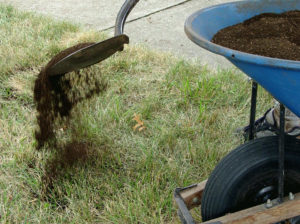That Fertilizer Question…
August 2nd, 2022
One question I get a lot – and can’t answer very well – is when and how much to fertilize plants.

Do we really need to use all of these?
It’s another one of those gardening questions where the only truly accurate answer is, “It depends.”
Factors include the nutrients already in your soil, the time of year, the weather, the particular plants, your expectations, and a handful of other environmental and plant-performance variables.
It’s really impossible to make a blanket recommendation to always fertilize Plant A with Product B at Time C.
Although some plants really do benefit from supplemental fertilizer at least some of the time, I’ve always believed that gardeners fret about fertilizer more than necessary.
The bottom line for me is that if a plant is performing reasonably well, it doesn’t need fertilizer.
Most of the time, plants are able to mine the nutrients they need from the soil – especially if the gardener has been adding nutrition from organic toppings such as compost, leaves, and/or mulch.
That’s particularly true with trees, shrubs, evergreens, and even most perennials. These have efficient root systems (at least in reasonably friable soil) and may never need any help from your store-bought bags and bottles.
If that’s not true, ask yourself, “How did plants ever manage to survive before Miracle-Gro was invented?”
But largely because of marketing, gardeners are convinced their plants will at least do better with regular fertilizing, if not croak without them.
University of Nebraska Extension Educator John Porter wrote in a recent Garden Professors blog post that gardeners often “add fertilizer out of habit or because a shiny package or advertisement told them they needed to do it.”
He says (and I agree) that the only way to know for sure if your soil needs fertilizer is to do a soil test. Otherwise, you’re just guessing on what the soil might need and how much.

Fertilizing isn’t an automatic or must-do job.
DIY Penn State University sampling kits are available for $9-$10 at county Extension offices, most garden centers, and online through Penn State’s soil testing lab.
Porter and fellow garden-professor blogger, the University of California’s Jim Downer, offer a few other thoughts on fertilizing:
1.) If your soil-test report says your garden nutrient levels are within a normal range, don’t fertilize. There’s no need to add fertilizer automatically or “just in case.”
You also don’t have to test every year. However, it’s a good idea when gardening in a new area, every few years in high-production beds, or whenever you’re not getting good growth results.
2.) If the soil-test report says your soil is lacking one or more nutrients, try to find a product that best matches what you need.
And add only the amount needed. Excess fertilizer can burn plants or pollute ground water, while out-of-whack breakdowns can be counter-productive to good plant growth.
Broadcast the recommended fertilizer in the recommended amount over the soil surface or water it in as opposed to disturbing the soil by digging it in.
3.) If you’re going to need fertilizer, it’s more likely to be in a vegetable garden, annual-flower bed, or similar situation where you’re doing a “high volume of growth and removal” every year.
Plants growing in containers are the most needy of all since they’re usually growing in soilless mixes and losing nutrients to leaching from all of the watering.
4.) Compost is a good source of nutrients, and applying a light layer of it over the soil surface each year (“top-dressing”) is probably all you need, especially in perennial gardens.

Top-dressing with compost is one of the best things you can do for lawns and garden beds.
As for timing, early spring is one generally good time so that the fertilizer nutrients are in place in the root zone for when most plants hit peak growth.
Any time plants are actively growing is generally OK, too… if the extra nutrition is needed.
A not-so-good time to fertilize is when plants are dormant, going dormant, or in slow-growth mode. Examples are spring bulbs after they’ve died back for the season, lawns and landscape plants that are trying to survive a hot, dry spell in summer, and houseplants during the dark days of winter.
Never fertilize frozen soil when the risk is high that the product will run off before it’s absorbed.
Except for plants in pots and baskets and maybe roses, now is usually a time when you can put the fertilizer bags away.
Roses are heavy feeders and usually benefit from monthly fertilizer through early August. Then knock it off for the year.
Established trees, shrubs, and evergreens generally get all the nutrition they need from the soil and seldom need supplemental fertilizer at all.
Landscape beds of flowering shrubs and perennial flowers usually do fine with just a spring shot of organic or long-acting granular fertilizer – if even that. They shouldn’t need anything beyond that in summer.
Lawns are best fertilized in spring and at the end of summer. Definitely do not fertilize them when the grass is brown or showing signs of heat/drought stress (wilting, yellow tips, blades turning yellow-green from darker dark green).
Read more on Pennsylvania’s new lawn-fertilizer rules that limit what can be applied when
If you take away only one thing from all of this, remember that plants need enough nutrients.
In other words, more is not better. Even some is not better if your soil already is nutritious enough.
Adding more fertilizer than needed is wasteful, possibly polluting, and is one of the few gardening jobs that you might be able to skip and save yourself a few dollars.







